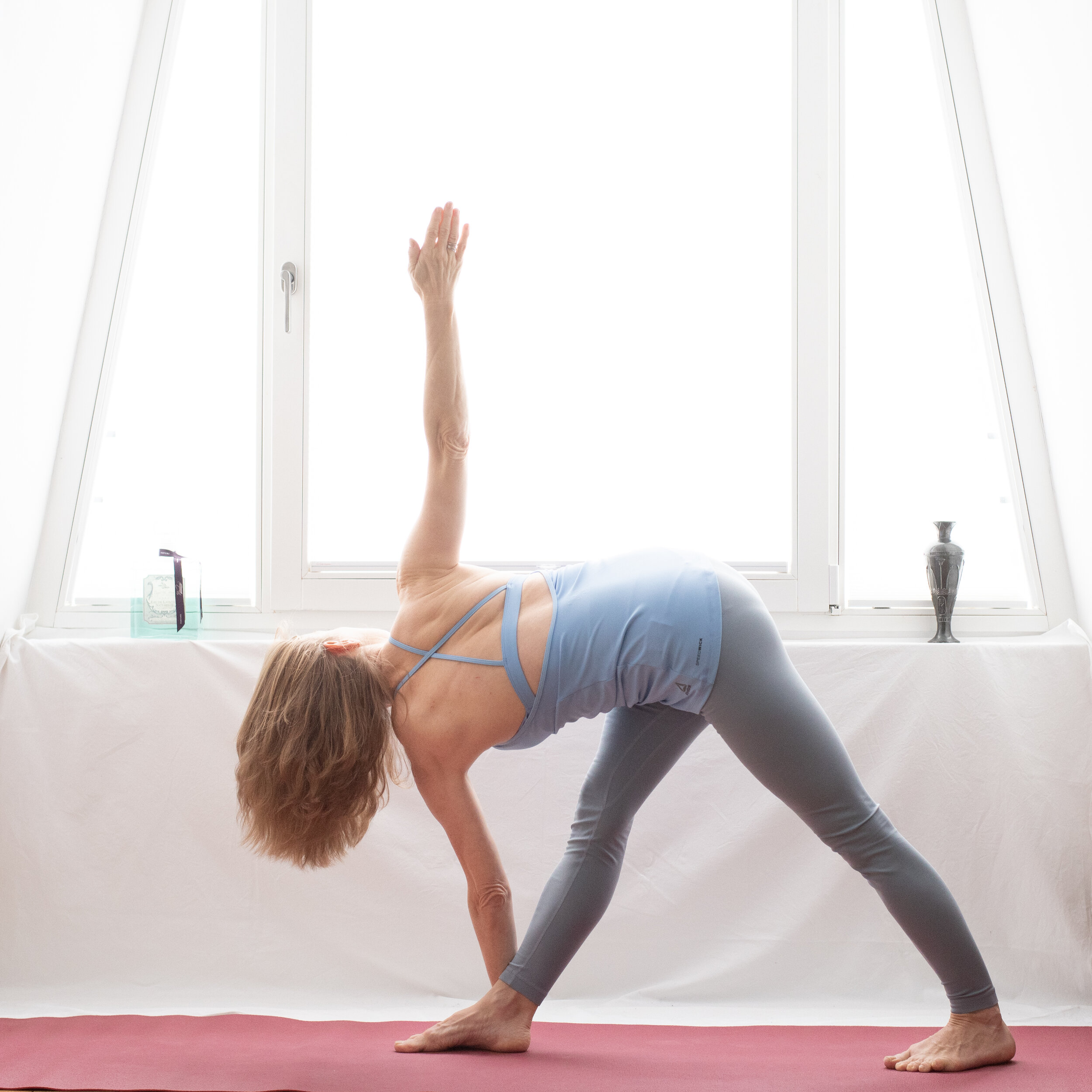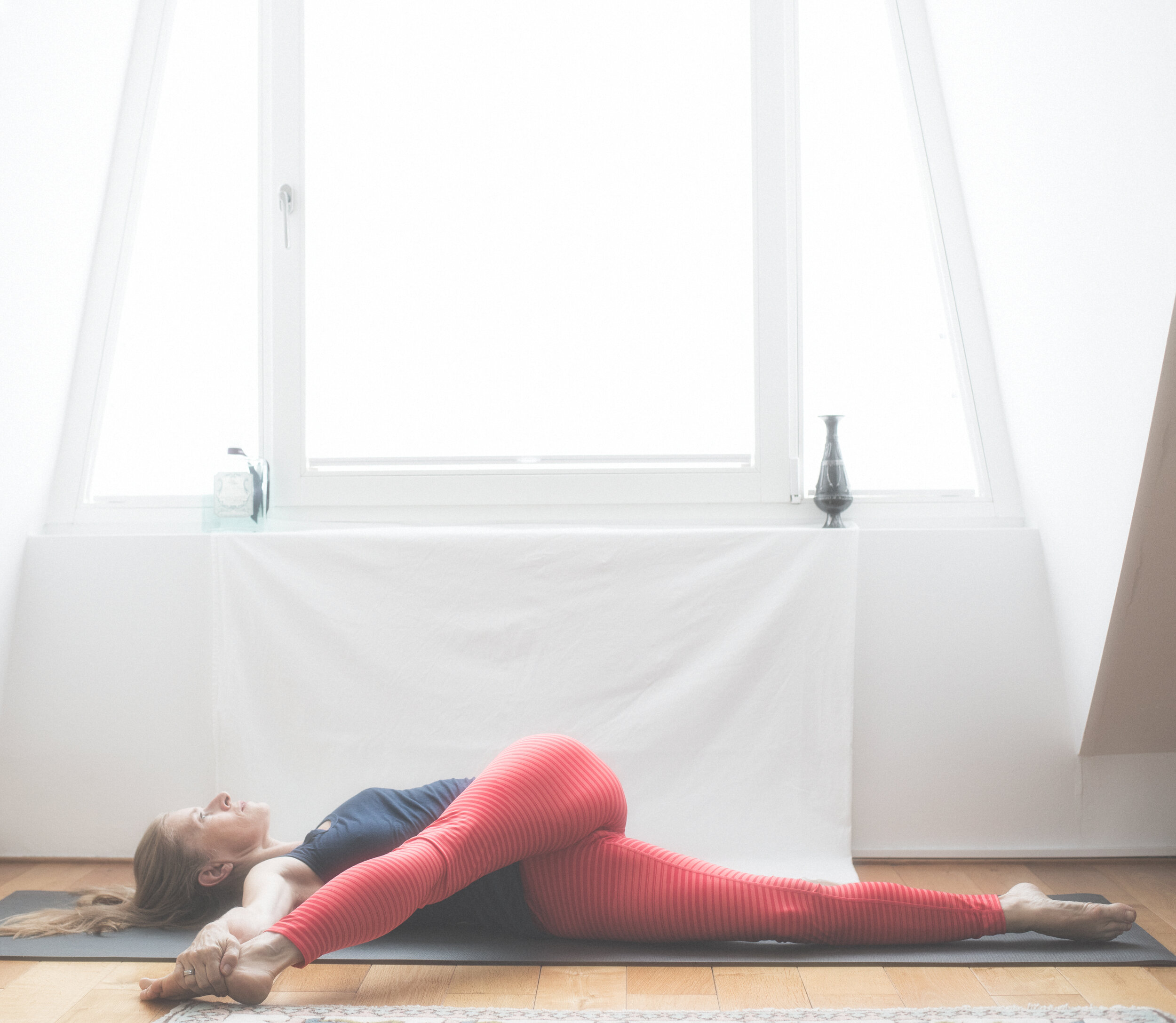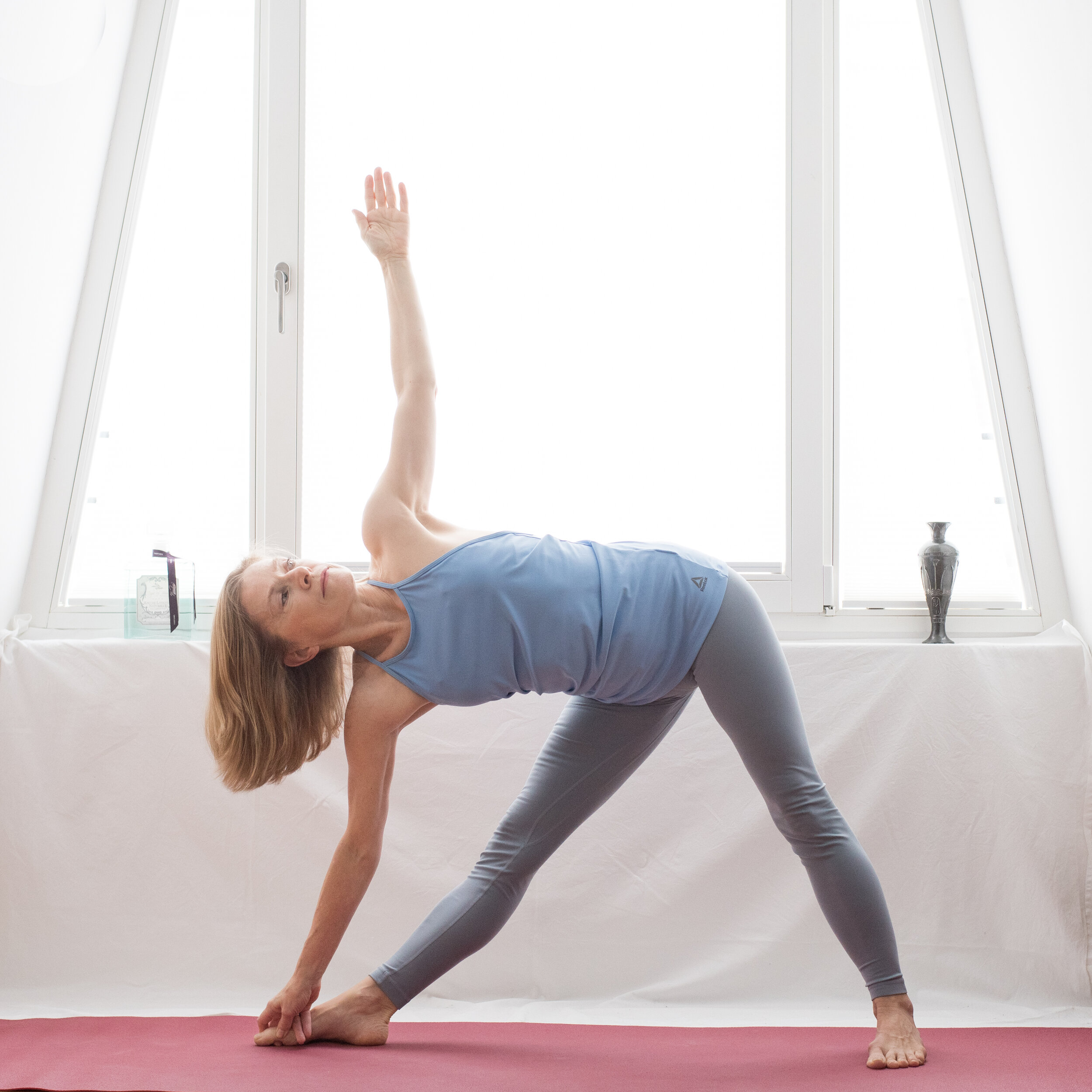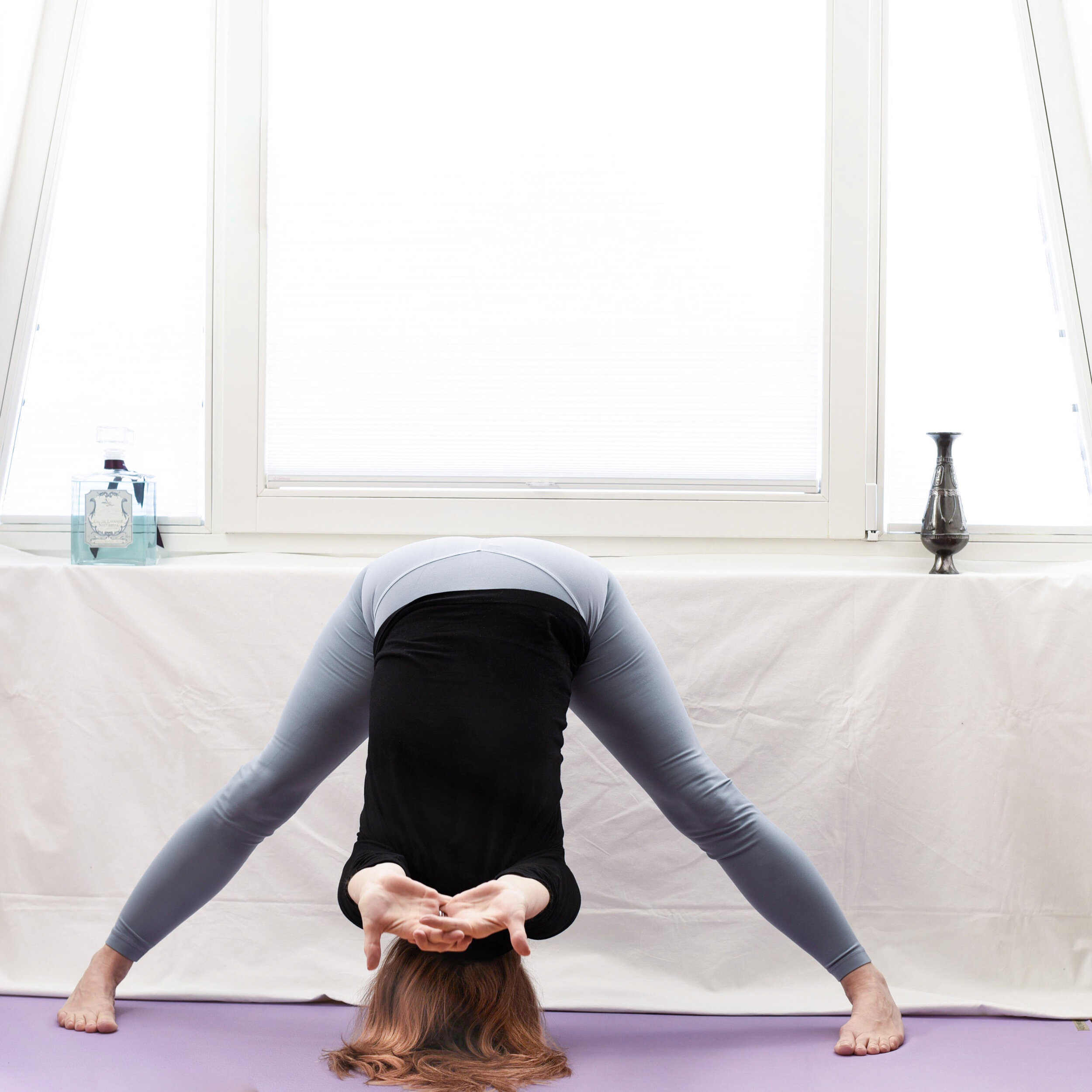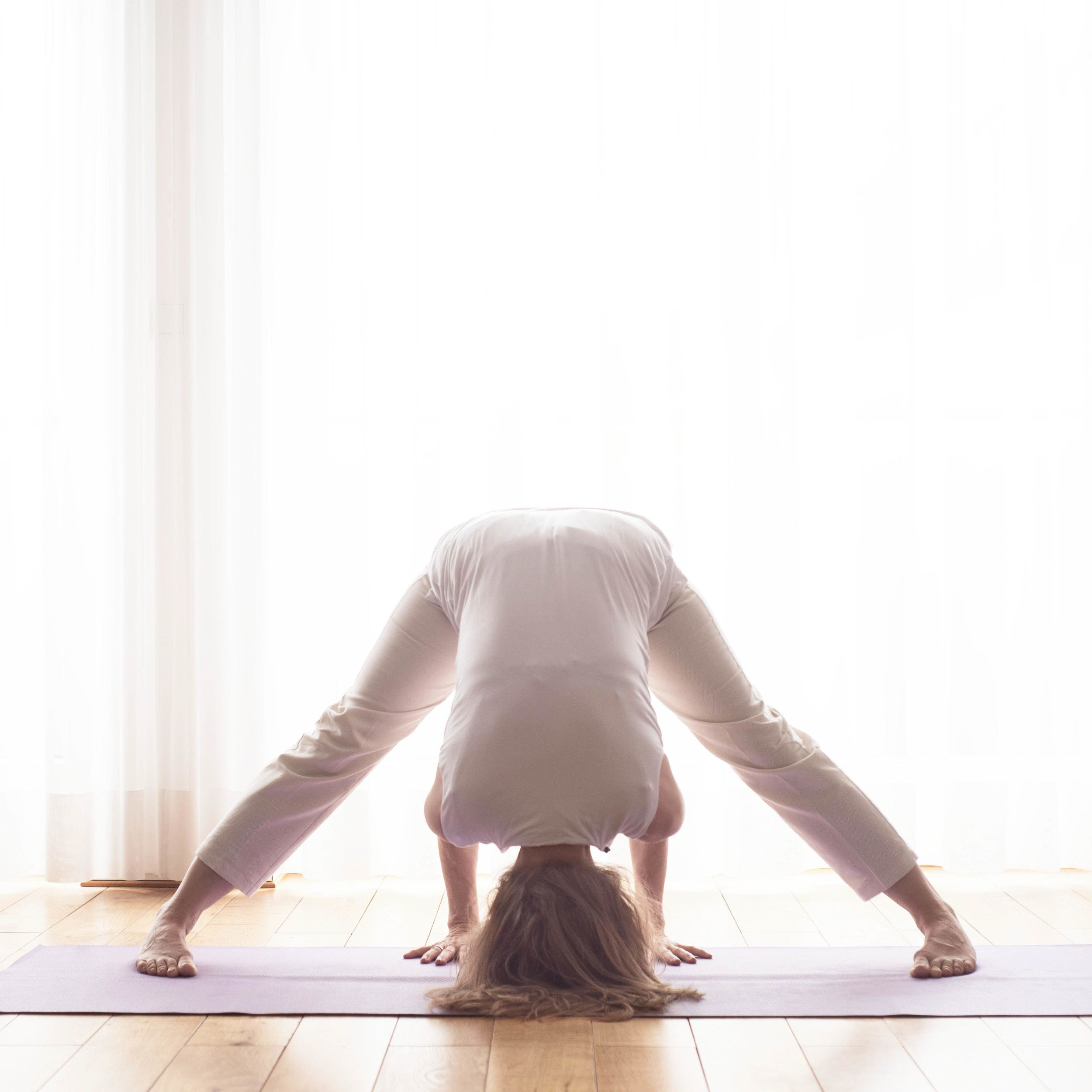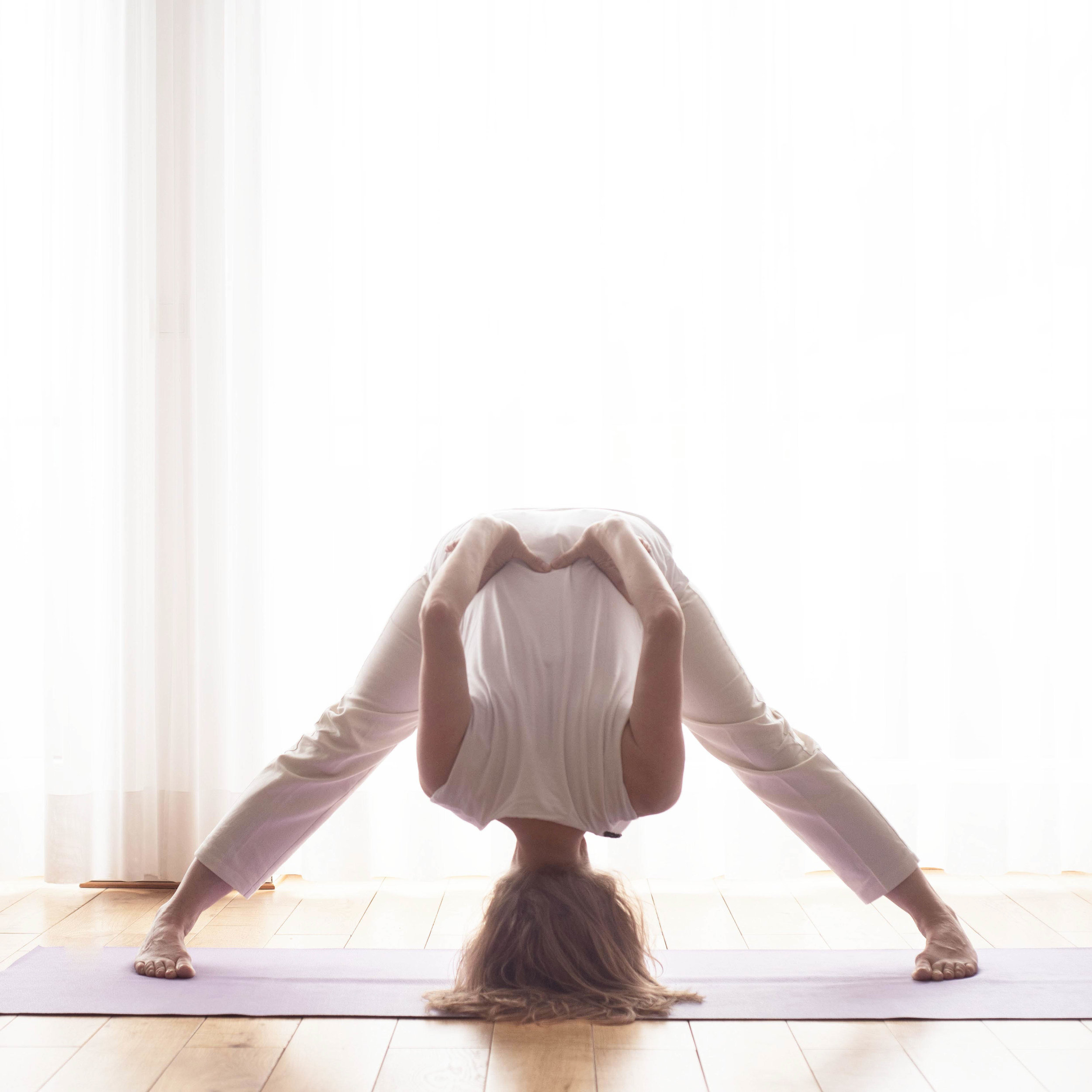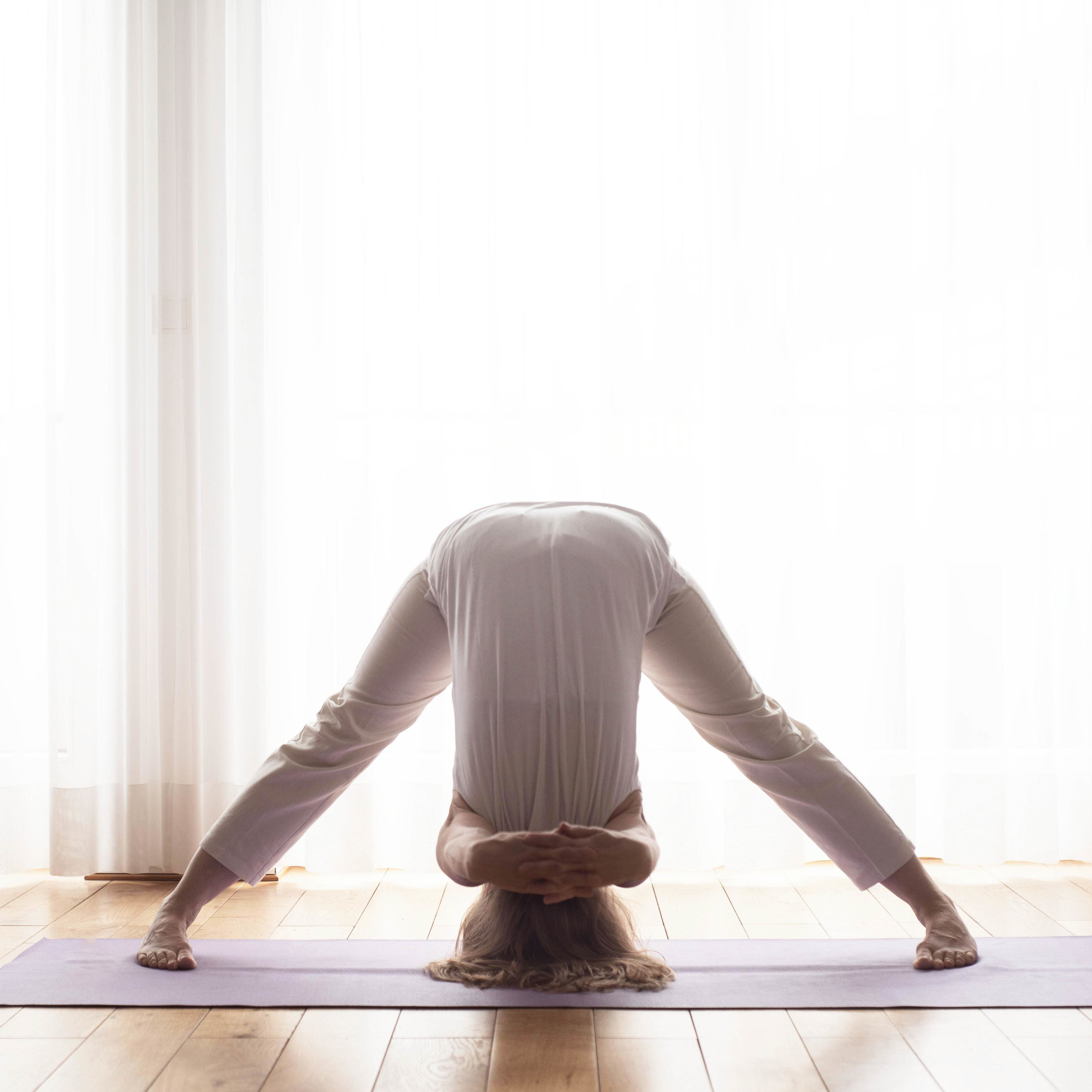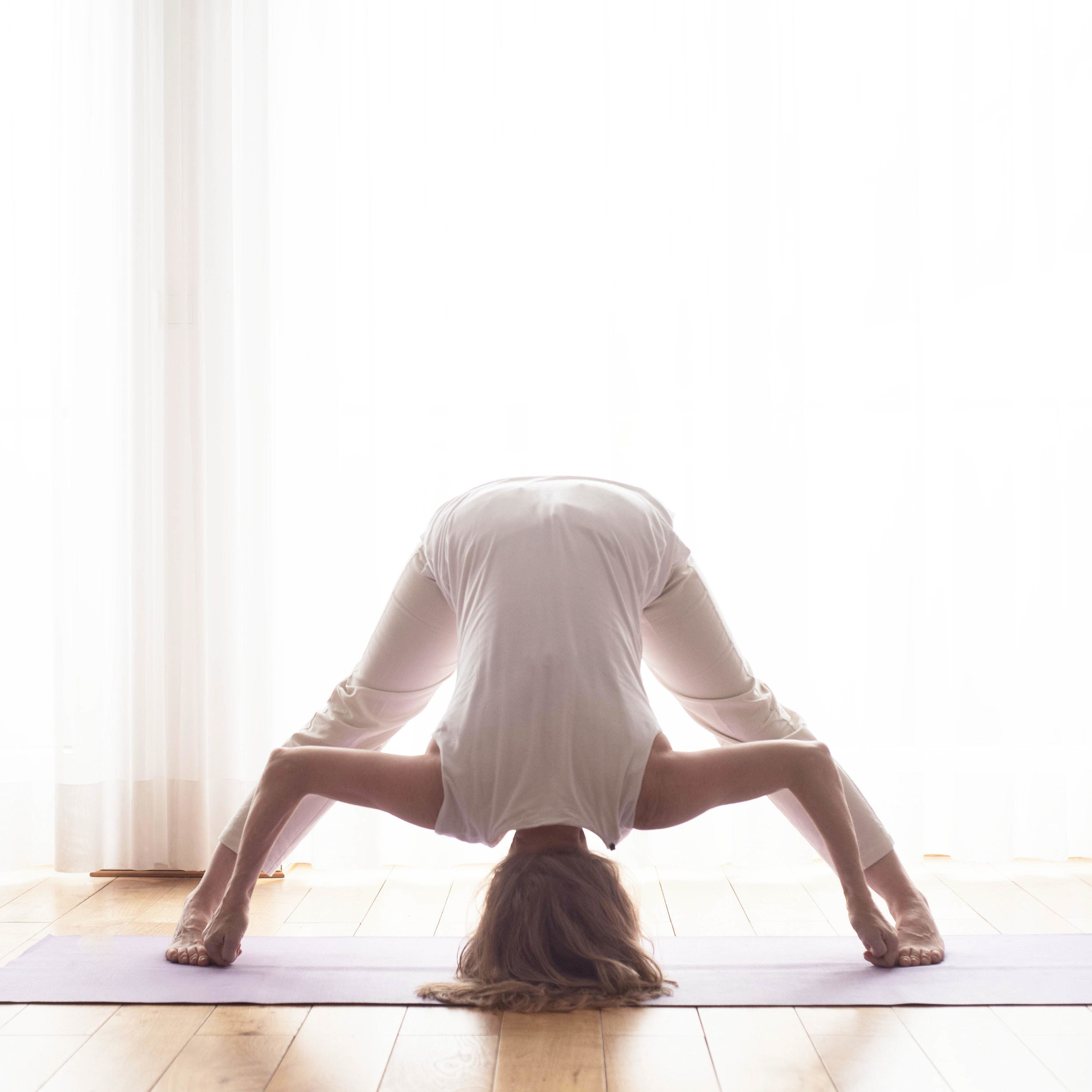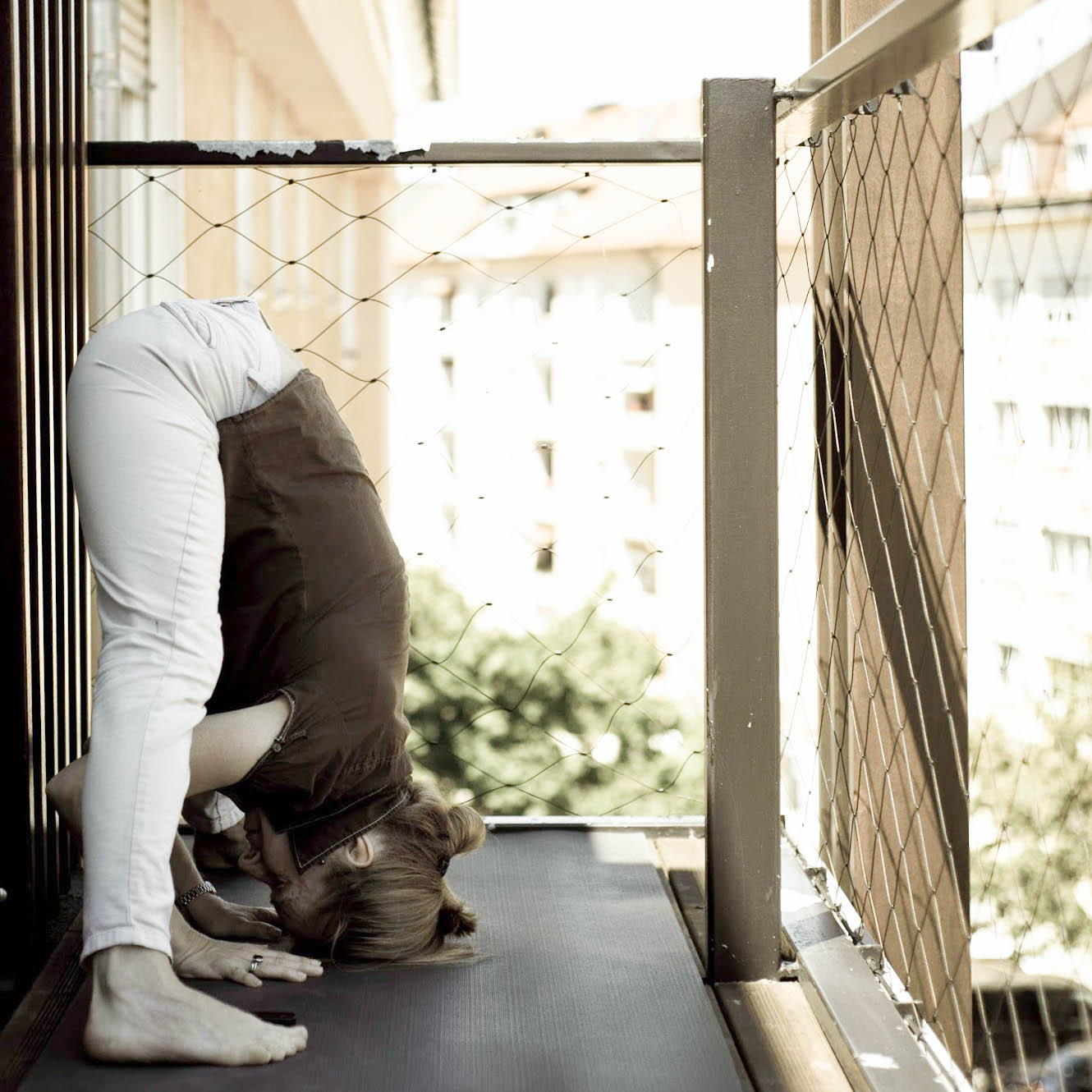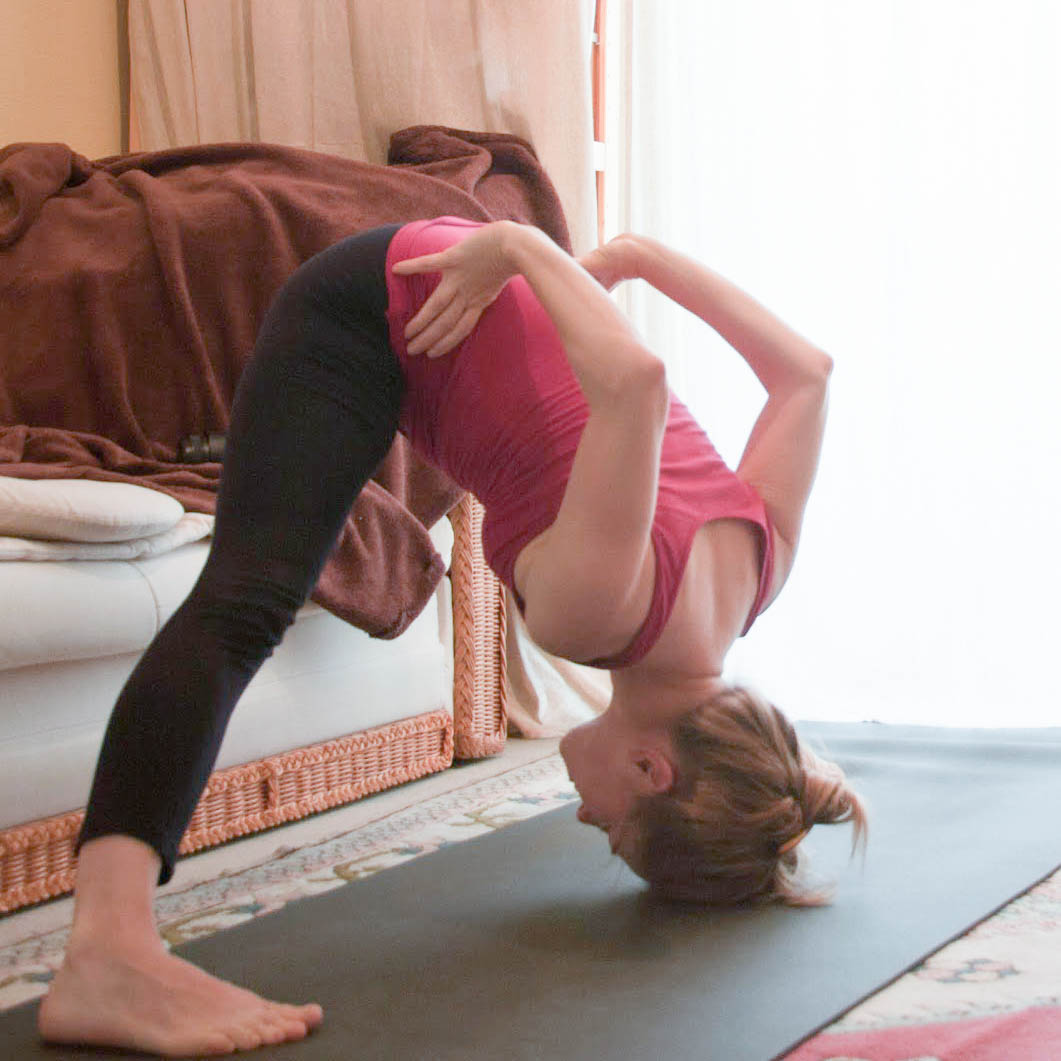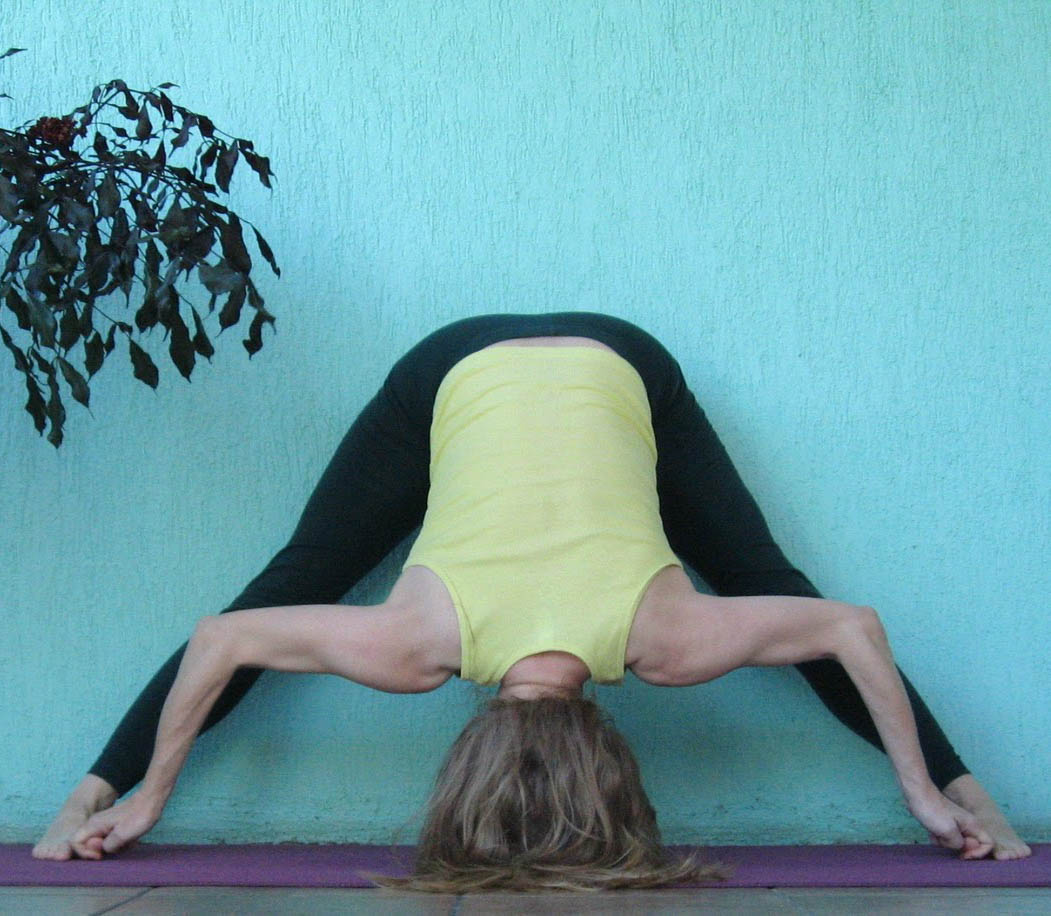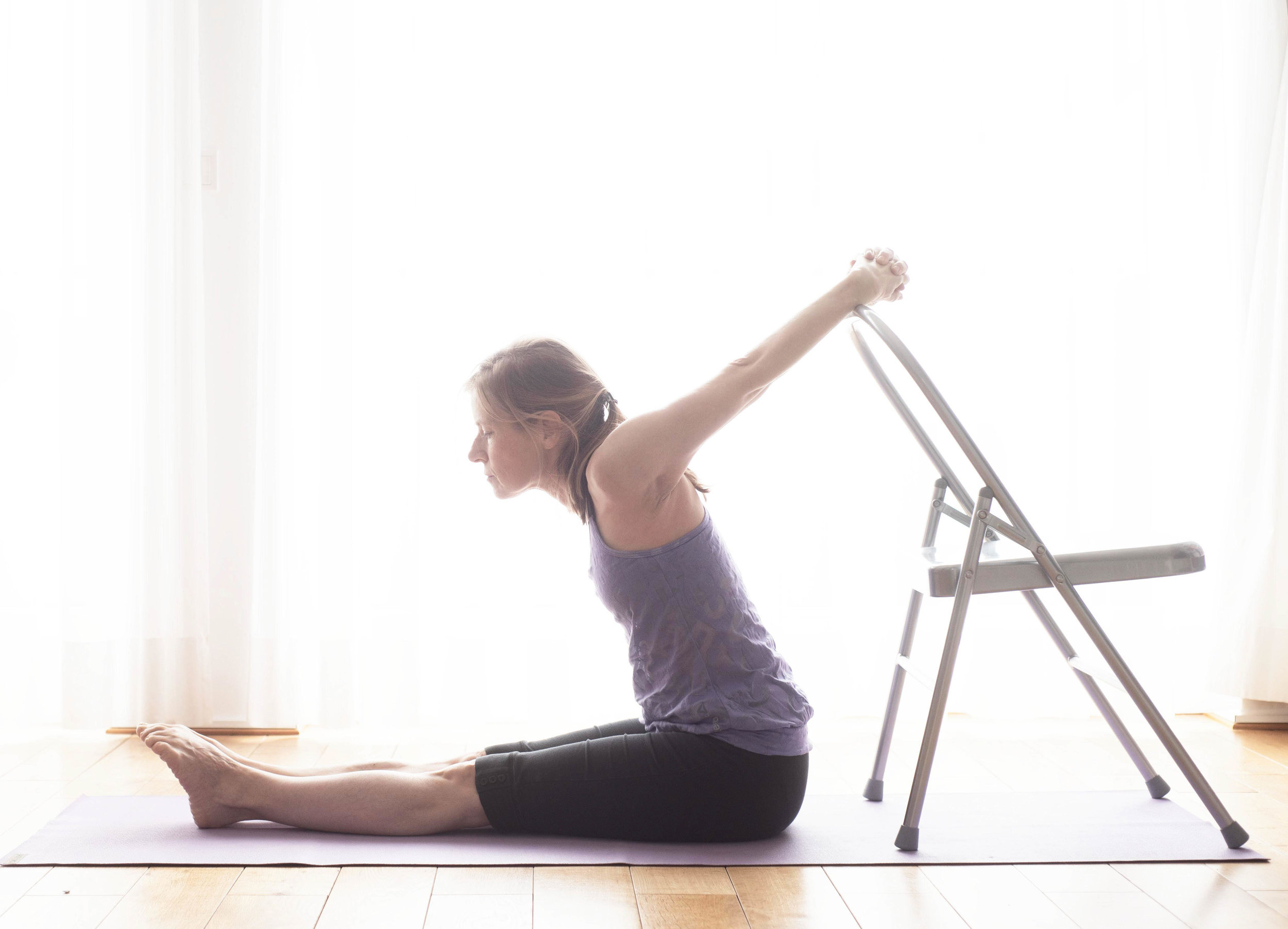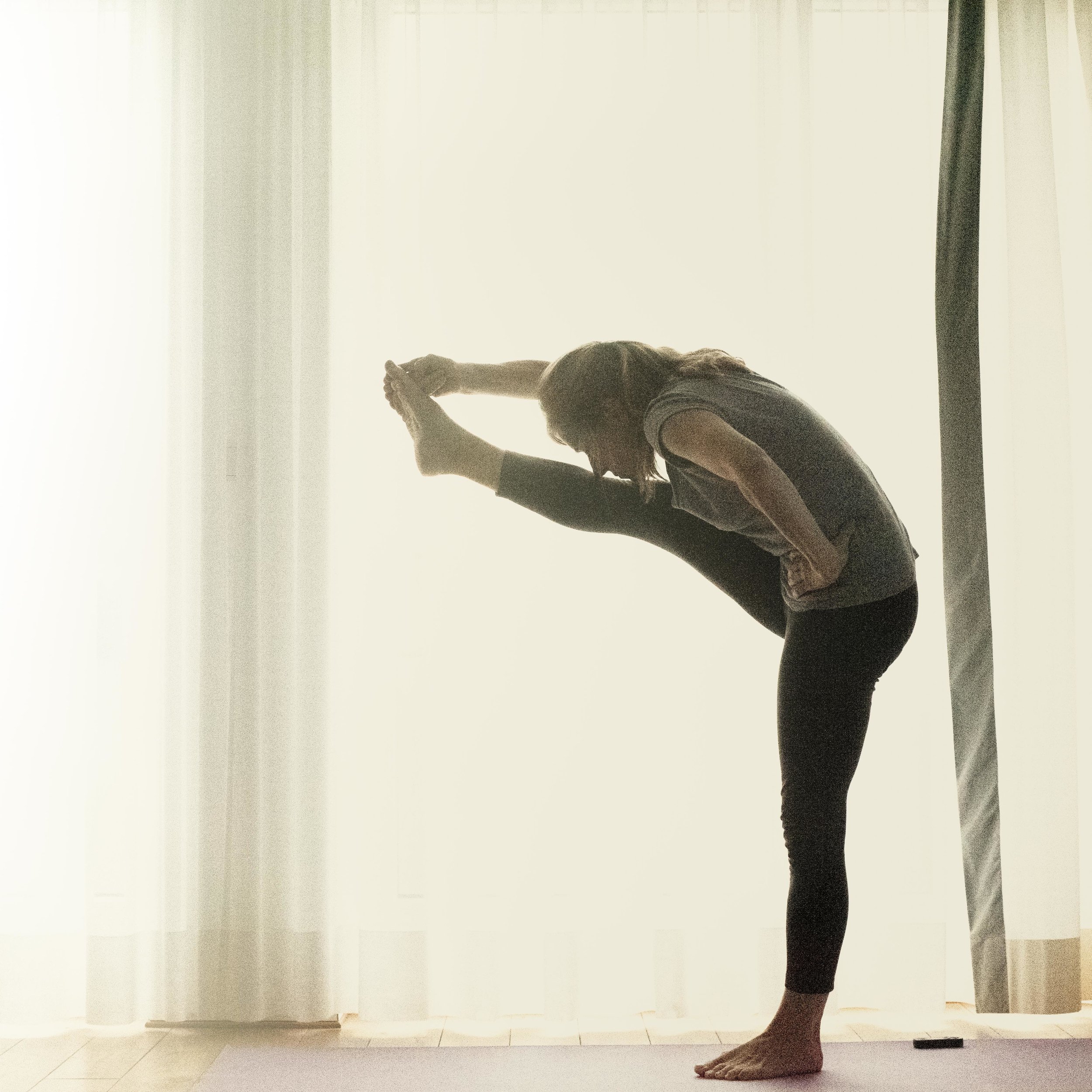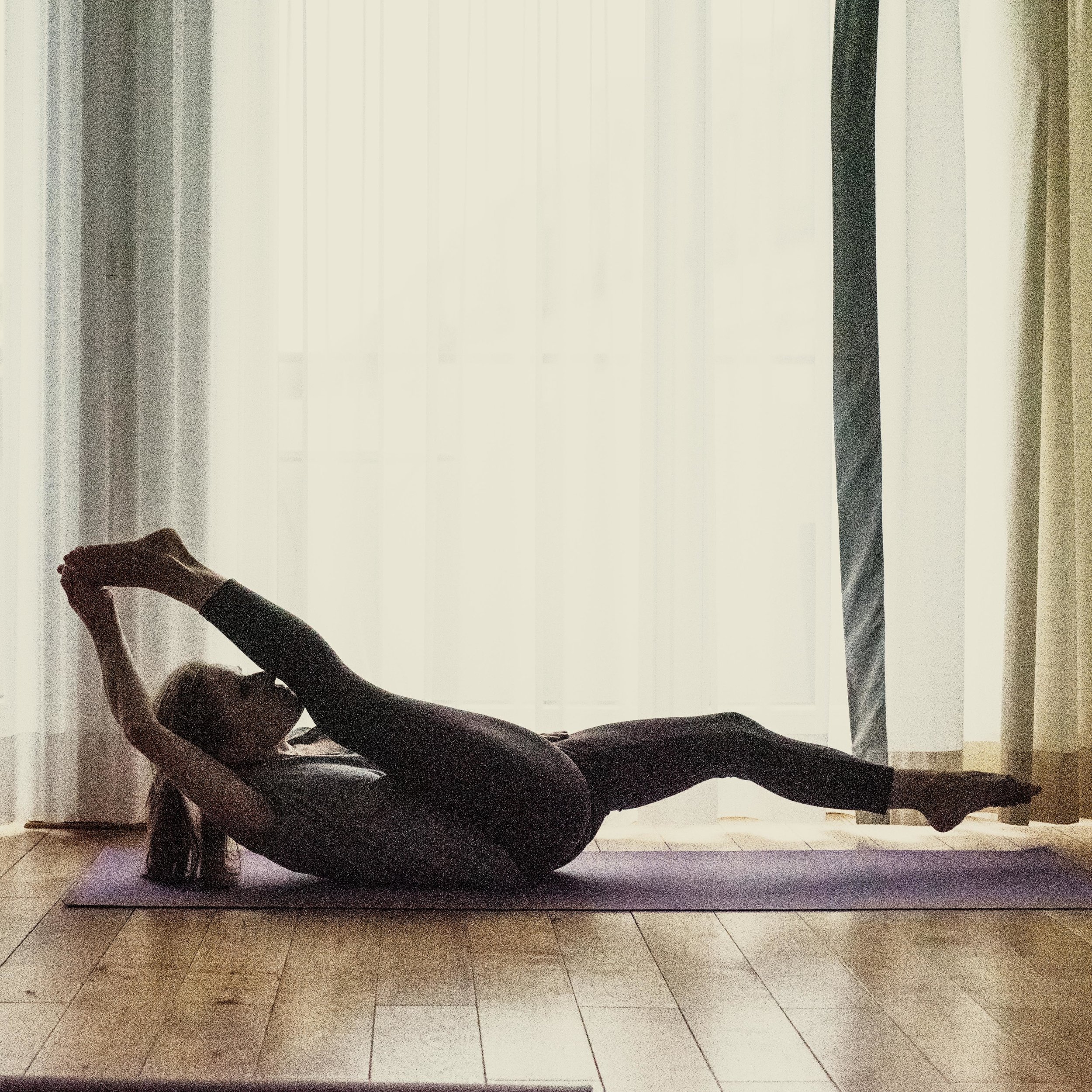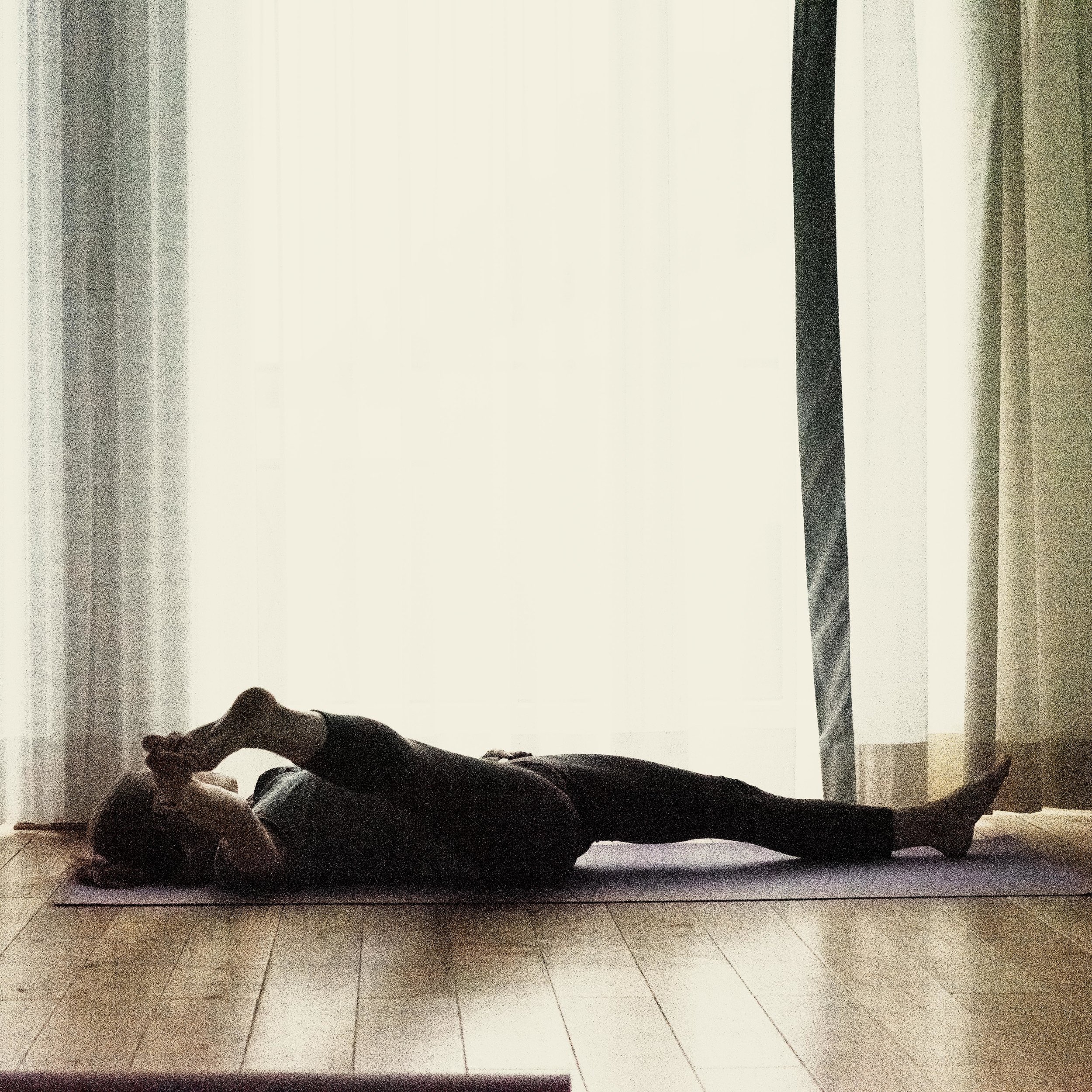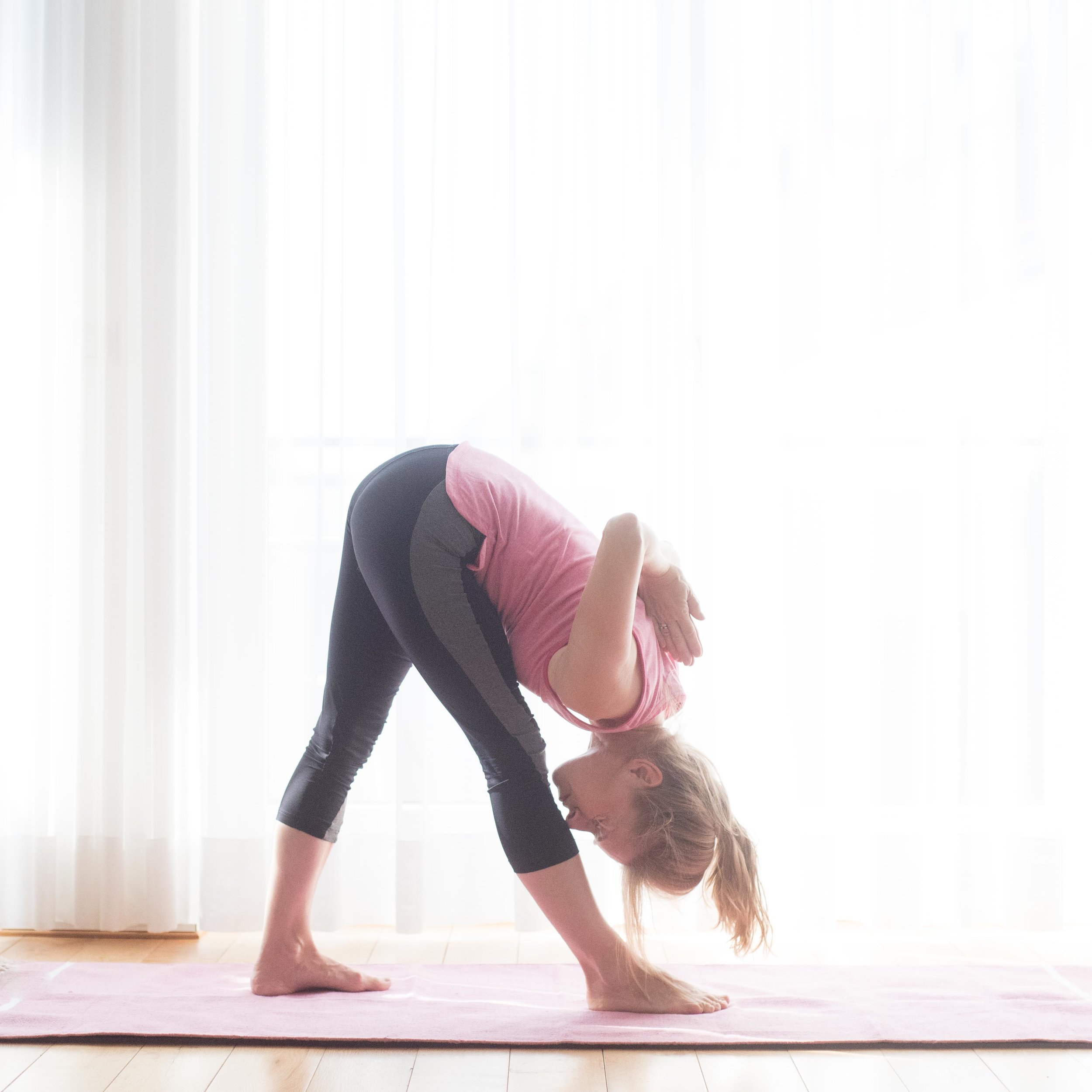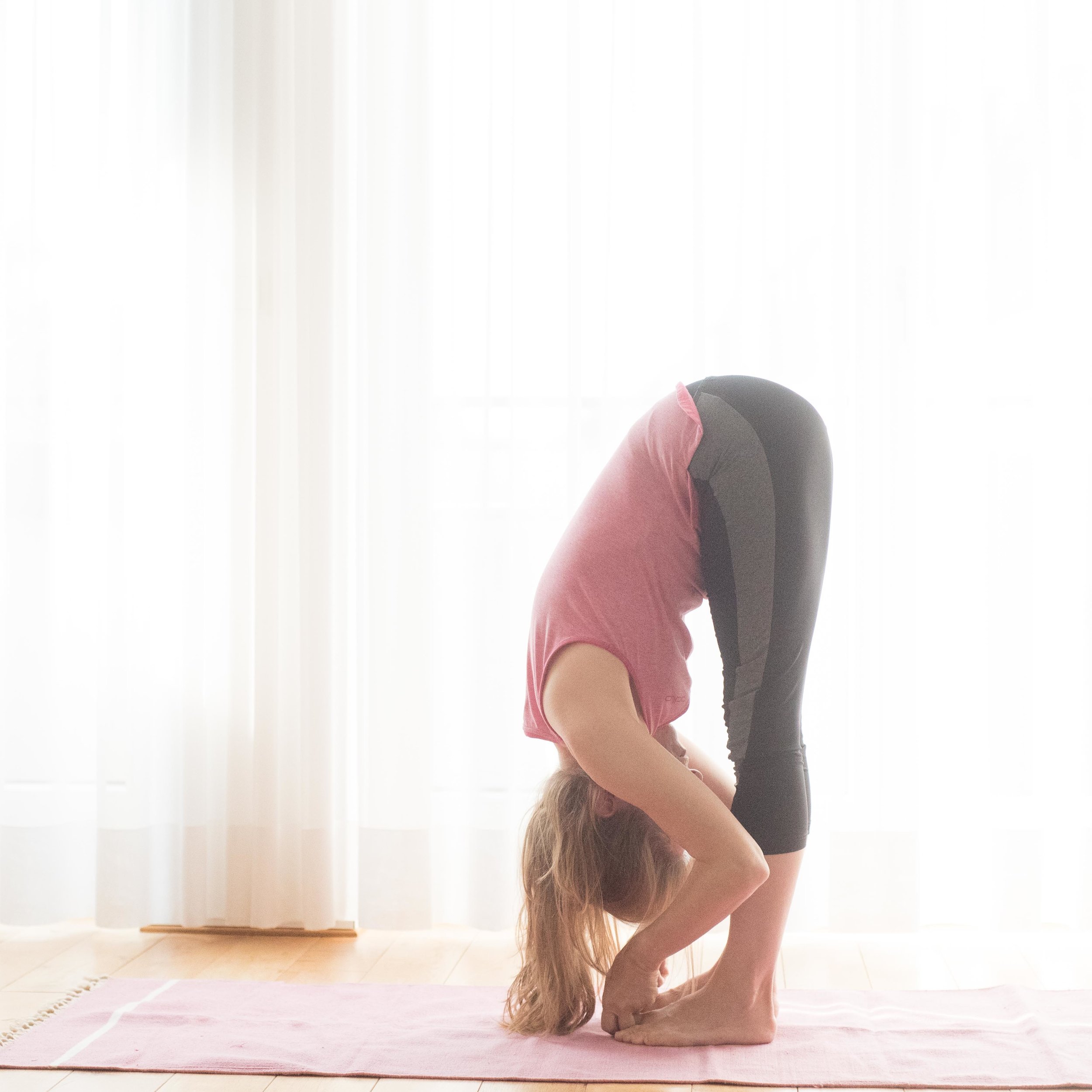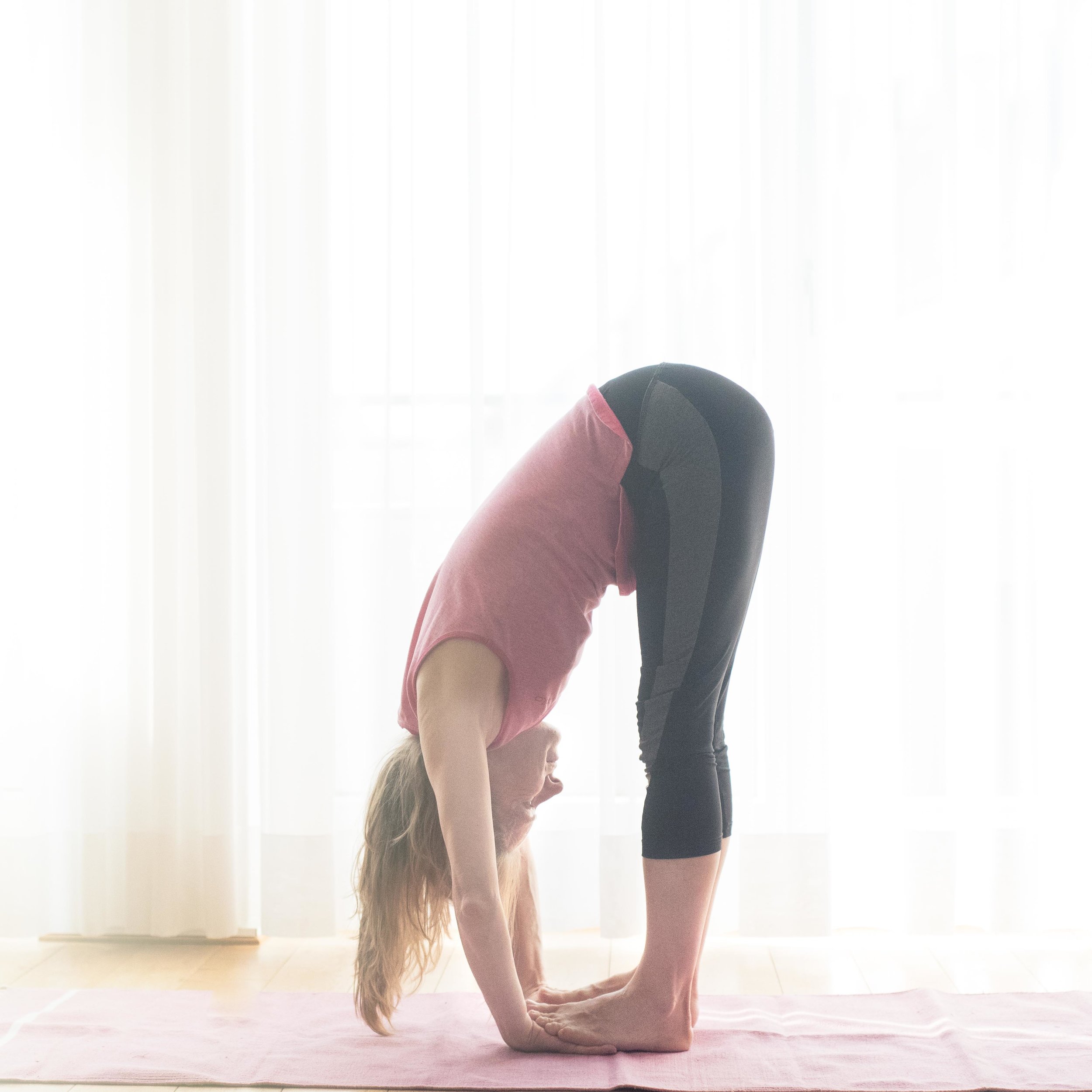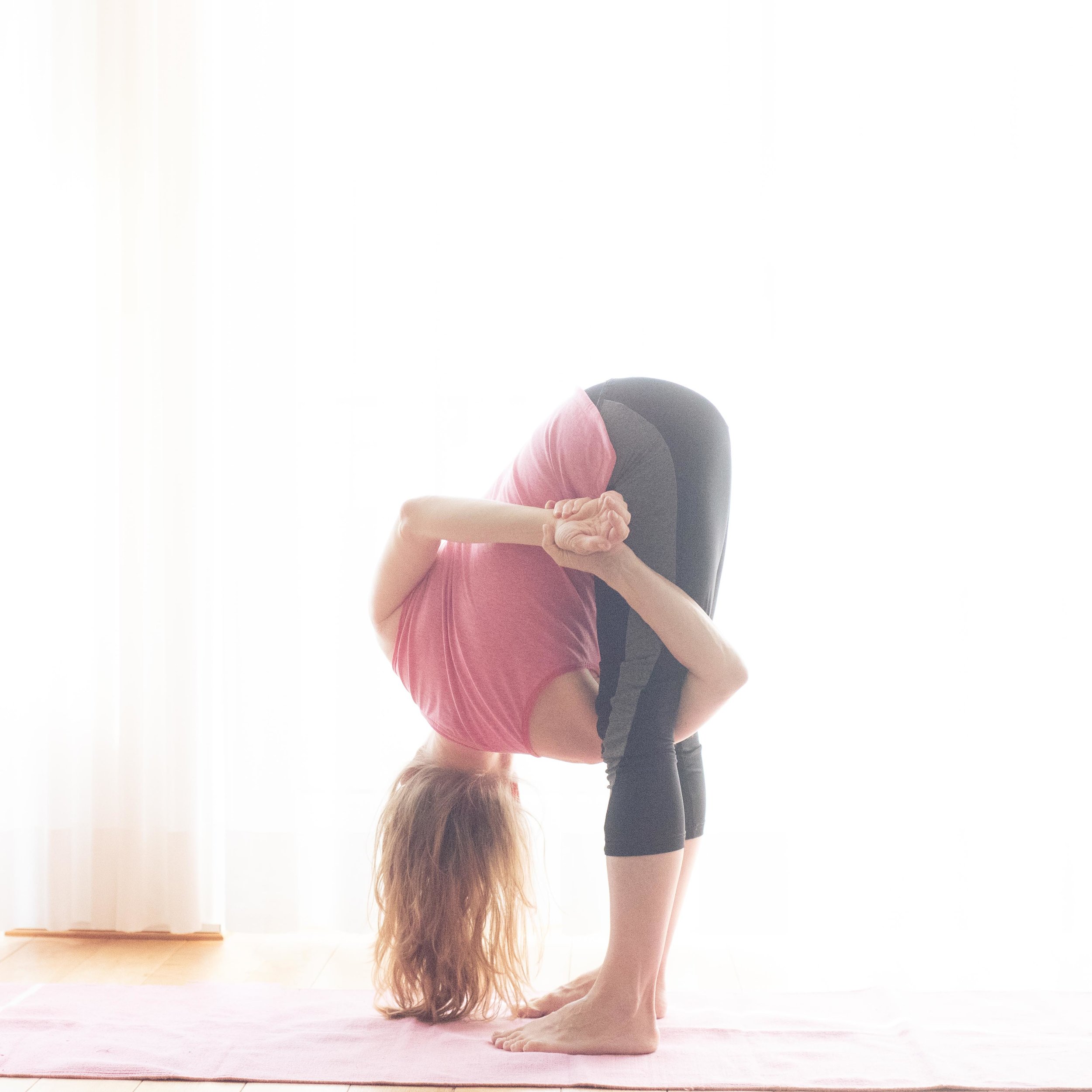Standing asanas
Standing asana, January 2023
In Ashtanga yoga you start with the sun salutations. This is immediately followed by the standing postures. Most standing postures are challenging as they often stretch and require balance at the same time. In order to balance well, you need to tense your muscles. Tense muscles stabilize the asana. The muscles are not tensed to their maximum strength. 70% is enough.
Tensing the muscles is necessary in standing poses. You will not fall out of the pose if you do not tense your muscles when you are in a seated position. But it still makes sense to tense the muscles to enable stretching. The body protects itself from overstretching when the muscles are tense. In the meantime, the term PDF stretching is used everywhere when the muscles are initially tensed when stretching.
I believe that I intuitively did this correctly.
Unfortunately, I am currently injured in my left hip. However, I am able to practise around the injury.
The most important thing for 2024 is to practise every day (6 days a week) and not take so many breaks. Regular practice protects you from injury. Every break brings frustration because the body quickly becomes inflexible and weak again. The older you get, the faster your body adapts to a 'lazy' lifestyle. Exercise is the be-all and end-all.
Even the best experience that it is sometimes difficult to practise. That's when it's important. That's the discipline you learn. You can't always give it your all.
Today I decided to take some pictures. My exercise was much less intense, but I practiced.
With this in mind, let's practise. Every exercise counts, even the short and lame ones.
Parivrtta tri konasana
A very short blog post today:
Exercise the position in picture three and parivrtta tri konasana will improve. Hold position of picture #3 for two minutes each side. I realized immediate progress of the standing asanas parivrtta tri konasana.
Practicing few additional exercises can make a huge difference.
Tri konasana
I’ll probably repeat the following sentence again and again: There is no easy asana. When practicing Ashtanga yoga the practice starts with the sun salutations. Then follow the standing asanas. They are difficult. All poses feel differently than they look. It’s a challenge to adjust oneself.
All standing asanas are balancing asanas. To engage the legs is important. The feet rather move to each other than apart from each other. The upper body is straight. In order to open the shoulders it can help to move the arm behind the back to the thigh. This allows to give oneself a nice adjustment, it helps to move the shoulder backwards. To stretch the arm like in the second pictures supports the straight line of the body.
To have a correct head position is not easy, too. It’s already good, when the head doesn’t hang. This looks lazy.
Many call this pose tri konasana, the full name is utthita tri konasana. Utthita translates ‘stretched’, konasana means ‘triangle’. The pose forms only straight lines with the body. Having the word stretched in mind helps to give meaning to the asana.
It’s a pose that is great for pictures. Arms, legs and the body are seen clearly. The limbs are separated from each other. It’s an asana that opens the upper body.
My yoga week began this morning at 6 am. At 5 am I got up, at 6 am I was ready. It was still dark, yet I didn’t like to switch on a light because I didn’t like to wake up my beloved E. It was absolutely OK to start before sun rise. It’s not necessary to see the details of the surrounding. At 9 am I had an intensive practice behind me, I was showered and I enjoyed a tiny breakfast. What a start.
Prasarita padottanasana C
Lately I saw a video on Instagram. David Robson, an Ashtanga Yoga teacher pointed at a mistake many yogis do. In this video a student showed the wrong and correct hand and arm position in prasarita padottanasana C. I checked If I do the same mistake as well. Yep.
In 98 % I practice the version on the right side of the picture. That is I don’t turn around the palms.
When I practiced the version of the left side, it felt awkward. This is why I scarcely tried it. Now I know why. I turned my arms in the wrong direction. The correct version feels so much better.
Matthew Sweeney shows the version that is on the right side on the picture, but his palms touch each other and the hands touch the floor.
Kino MacGregor and Gregor Mahle show both versions in their books on the second Ashtanga Yoga series.
The shoulders experience a deep stretch but it feels as if I can work with the body and not against it.
If you don’t know if you turn around the arms in the right directions, check your elbows. They are totally straight when the pose is performed correctly. The elbows are slightly bend when the arms are not turned around correctly
Learning never stops.
Practice report:
This morning I practiced primary as close to the original series as possible. No extra asanas were planned. It was exhausting enough. Soon I omitted the vinyasa. I know that I need a break on Saturdays. A day off gives fresh motivation. The body and mind are relaxed. Every day is so different. Every practice is better than no practice. Only this one more practice this week, I tried to convince myself. The practice makes modest. One can never be sure what happens next on the mat. Sometimes it’s a fight, sometimes a piece of cake.
To get enough sleep is important. During these Corona times there is no night life either. Having a night life is overrated. In other words. These days I prefer the mornings, the calmness, being one of the first who gets up.
My multi timer:
Multi Timer
This is a screen shot of my multi timer that I recommended a few days ago. It allows to run different timer at the same time. There are alarms available that switch off automatically. So, when I’m in headstand there is no need to get out to switch off the alarm. Sometimes it’s possible to hold am asana longer. Why stop oneself. It’s possible to create different register with an own clock and different timers for different activities. I have a file for Yoga, one for photography and another one for chores. This multi timer is what I needed.
Now I’ll lean back, I’ll close my eyes. Sometimes doing nothing is the best I can do. Oh, there is this interesting book on the table on Robert Frank………’American witness’.
Trikonasana
The standing asanas build the foundation of the Asthanga series. They are practiced every day. . On a sticky mat it doesn’t matter if the legs pull apart from each other or if they move together. The sticky mat prevents the feet from sliding. On the grass it’s crucial to engage the leg muscles and to take care that the feet rather pull to each other than apart from each other. This gives stability to the asana. That’s the goal to be grounded and to stand stable.
It’s possible to engage the leg muscles without any inner direction. The legs and feet can move slightly together or apart from each other. One can feel a huge difference even though nothing might be seen.
Even when learning side split. The legs move together when they are in position.
The inner body work is important.
Correct muscle work helps to perform an asana savely. To engage the muscles also supports stretching.
Practicing on soft grass, in fresh air is a joy. I avoided sitting asanas. I didn’t like to spoil my clothes.
Prasarita padottanasana
A new decade has started for me. A new month has started, too. Since I practice at home these days I’m a student of yoga, but at the same time I’m also my teacher. How to look at me from the outside is the question? A most useful tool to give myself feed-back are my pictures. Even a teacher cannot correct everything. A picture reveals a lot. The asanas feel differently as they look. That’s why one must see them.
Within the last decade my forward bending got much better. I still have to work on taking my hands to the floor in prasarita padottanasana C. It all improved, but not at the speed that I wished.
I don’t follow the Ashtanga Yoga method blindly these days. I know that extra asanas, strength training, holding the asanas longer than 5 breaths can help enormously.
The pictures of the past are taken in 2011 and later. Pictures also report progress. They also report if no progress happend.
Last year I went to a yoga class and the teacher told me that I should aim for taking my arms to the floor in prasarita padottanasana C. It became unimportant for me. But after this feed-back I focused on performing this asana properly again. Just doing it is not enough.
Here are my extra asanas that shall help me to make my hands touch the floor finally without the support of a teacher.
The last pictures show the exercises that I practice before prasarita padottanasana. I prefer exercise #1 as I need no chair. The trick is to hold the body up to one minute, so that the body can get used to this position.
A word of caution: The shoulders are a very delicate joint. It’s a very flexible joint. We can move the arms in all directions. It’s also important to build strength to protect the shoulders. Many yogis exercise handstand before they have the proper flexibility and strength in the shoulders. This might lead to injuries. Practice with care.
Self-study
How to be an autodidact?
Those who practice at home are autodidacts. There is no teacher who can give feed-back. No adjustments are given. Nevertheless learning takes place. I think it can make sense to understand the learning process. It can accelerate it.
When learning a new asana it can make sense to divide it in tiny steps. Most of the time interim steps can be exercised. To progress slowly is not so frustrating than trying to perform the end form of an asana that is not yet possible.
Sometimes it’s also necessary to vary an asana due to injuries. This was not the case in the pose in the picture (ardha baddha padmottanasana), yet I know other poses that were not possible anymore after my SI joint issues.
How to understand an asana:
The first step is to define the asana. In the above picture we see half lotus, a forward bend and a balancing challenge. To learn lotus pose might take time. To open the hips is not done in a few sessions. To bend forward means to lengthen the body first. The movement starts from the hips. In order to facilitate any balancing pose it makes even more sense to breathe evenly. to engage the bandhas, to gaze at a point and to keep the eyes calm. These hints can be a guide. They are instructions.
The vinyasa is important, too. Often several ways to get into an asana are possible. The above pose usually begins with posing the leg in half lotus. If this is not possible to look for variations starts here. I.e. one can put the foot against the leg. To do this the hips have to open much less than they have to when performing half lotus pose. This might be a first step.
It’s important to find out the own limits. Then one can push them. Forcing oneself into a position that is not yet possible makes not so much sense. Observe your face. Is it relaxed?
Performing easier poses that are doable or exercising interim steps is not the recommended strategy of the Ashtanga yoga community.
Due to my back injury I was no more able to perform asanas that used to be easy for me. I had to exercise variations. I had to omit asanas. That’s why I withdraw from classes. I had to….. This helped me to heal. Yesterday I practiced primary at home with no back pain at all. I could do all the surya namaskara A and B. It exhausted me, but I could do them. I got so weak, but I got stronger already. Patience is necessary. I’m more than happy that I can practice again. That this injury would last 2 years is still a shock for me. I’m so happy and thankful every time I’m on the mat. I see much light at the end of the tunnel. It has been a lesson in being patient and trusting that everything can get better again.
Summary:
Define the asana and find interim steps to get to the final pose. If the final pose is easy, one can search for asanas that are more demanding. Listen to your body.
Half lotus pose gets introduced
We’re still talking about the standing asanas. Half lotus pose gets introduced. This alone is a challenge. Most people in the Western world are not used to sit on the floor comfortably. Not enough. It’s combined with a forward fold. This turns the asana also into a balancing pose. We face three challenges: half lotus, forward fold and balancing. In addition the hand shall hold the foot.
I thought I’d never master this pose. I did. Lotus pose was easy for me. I had difficulties to reach the foot with my hand. One day I found out that I could twist in order to reach the foot. Then I can return to the original position. Then I could bend forward. The pose was mastered. In the beginning I felt dizzy when I came out of the pose. This faded away with time.
Important is to put the hand firmly on the floor. It helps to turn it inwardly. This gives even more stability.
Later in the first Ashtanga yoga series comes an easier variation. It’s the same form but it’s performed while sitting. It’s called: Ardha baddha padma paschimottanasana.
When performing this asana the balancing challenge goes to zero. That’s why this asana is a good preparation for the standing variation.
There are quite a lot asanas that have the same form but have another orientation. Some are exercised while standing others while sitting or lying on the back.
Easier variations for Ardha baddha padmottanasana are when putting both hands on the floor.
Knowing easier variations and more demanding ones can deepen the understanding of an asana. It allows to practice more flexible if necessary.
Time frame
How long will it take to do the side splits?
Stretching takes time! A lot of time.
If one is too greedy one risks to injure oneself. This means that it takes even longer than without injuries.
Last week I saw a YouTube video by a young man, who managed it to do the splits. He looked very muscular. Yet he also stretched. It took him 18 months to do the splits. He started from a very high position like me in the above picture.
I’m 47 cm (= 18,5 inches) away from the floor. I guess it will take 2 years to do the side splits, also when I exercise it on a regular basis. In addition In the meantime I learned ways to stretch effectively.
Splits are a huge project. Not every day progress can be felt. The opposite is the case. There are setbacks, too.
In the next posts I’ll describe the stretching method that I apply these days.
The splits get introduced
The asanas in the first row are utthita hasta padangusthasana, utthita parsvasahita and utthita eka padasana.
The next two asana are supta hasta padangusthasana and supta parsvasahita and they are very similar to the first two asanas only that they are practiced while lying on the back. Yet this makes a difference. These asanas are practiced at the end of the middle part of the first Ashtanga yoga series.
The asanas of the second row are easier as there is no balancing aspect. They tell me my current level. When I cannot take my leg to the floor without lifting the other hip, I shouldn’t move the leg to the side when standing either. One should never sacrifice the position of the hips. It’s so easy to cheat, but one only cheats on oneself. My leg points rather forward than to the side. But that’s it.
The first asanas of both rows are forward splits. The second asanas of both rows are side splits with one leg. This is one reason why I work on the splits more intensively.
I think these poses should look more advanced after 12 years of daily practice. But just doing it and holding it for 5 breaths is not enough.
How to balance:
Many years I thought I must balance with the standing leg. Yet I even read that the knee should be locked. These days I lock the knee.
Utthita hasta padangusthasana: I bring the hip forward and pull the leg backwards with my hand. If the force is the same, the body remains stable.
In addition I breathe evenly and deeply.
My bandhas are engaged and I gaze sidewards (not down to the floor).
It’s possible to exercise how to balance. This is also a skill that can make life safer especially when growing older. Many people fall when they get older. They cannot balance anymore. Then they often break bones and injure themselves. Fear arises. The danger of falling can limit a life. It’s just another reason to practice balancing asanas. Practicing yoga is worth every minute.
Utthita hasta padangusthasana was another pose that I couldn’t perform due to my injured SI joint and the consequences that followed. I learned from a video with Stu Girling that he had the same issues. He recommended to learn to lift the leg higher first before bowing forward to the shin bone. For me it was not more possible to bow forward. I’m astonished and glad that I could do the pose today. Miracles happen.
I’m always astonished how demanding even the standing asanas are. But that’s Ashtanga yoga. It gives us a lot to bite on.
My next posts will be about stretching, because that’s what we do when we practice yoga.
Utthita parsvottanasana
Utthita parsvottanasana is possible again without pain. This is relatively new. I exercised variations during the last two years. I put my hands on the floor to support the upper body. I couldn’t hang forward. I also moved from downdog in this position. These were the main variations that I exercised.
I had to be creative and I had to find positions that were similar to the original pose during the last years. Number one rule was that the performance of an asana shouldn’t inflame my back pain. Even though I came to the conclusion that there was no physical damage anymore I had to take care. My pain became chronic, the pain system was out of order. That doesn’t mean that one cannot experience pain. Pain can be experienced also when there is no physical cause anymore. The mind can create pain as a precaution. I had to redo this malfunctioning of my brain.
When I have (or want) to modify an asana I usually wonder what sort of asana it is. I want to practice close to the original Ashtanga yoga series, but I also adjust it to my needs. In the above case it’s a forward bending asana. The position of the arms open the shoulders and the upper body.
Often easier variations of an asana exist, but also more difficult ones. It’s the task to find asanas that are doable but have almost the same effect like the original asana.
I often look for asanas that count as exercises. They shall help me to learn a challenging asana. In the above case I stretched my straight arms behind my back and moved them over the head forward. This had a leverage effect. Yet I also remember that I overstretched my hamstrings that way once. One should always practice with care. It’s nonsense to force the body in asanas that are not yet possible. Patience is a skill that one can learn. Yet it’s also true, if nothing can be felt, nothing moves. To learn how to learn is the true challenge. Where are the limits and how can I push them is an important question.
The further the legs are apart from each other the easier the pose gets.
Yesterday I saw a movie on Instagram: 2 guys forced a rather stiff man into upavistha konasana A. It’s explored scientifically what makes sense when stretching the body and what makes no sense. To force someone into a pose is so dangerous with not much result. This all has nothing to do with yoga, but with ignorance, unhealthy ambition and aggression. The ignorance of HOW to stretch correctly or more generally spoken, HOW to learn asanas is one of the main critics I have these days. Instead of learning how to stretch effectively , the community refers to a tradition of the last century. The tradition has changed already (not for the better), yet not the ignorance. That’s why the learning process is so slow in the Ashtanga yoga community. People don’t learn asanas because how they are taught to exercise these asanas is not effective. To be precise: To stay in an asana for 5 breaths only is not long enough. I’ll write more about this topic.
Utthita parsvottanasana is usually the last pose of the standing asanas if one practices the first series and many of the asanas of the second series, too. This makes sense as the practice would last too long otherwise The standing asanas have still seven more asanas. Some must be practiced on the right side and the left side. This is time-consuming. I used to practice 2 and a half hours. The output didn’t correspond to the effort I had put into that practice. At home I can do better. Hopefully. I shall see. It’s an experiment.
The next asanas are interesting ones. I’ll write about it in my next post. I practice them these days as I alter first series and second series. I limit my practice to 90 minutes.
Main thought of this post:
First I analyse the asana. Is it a back bending, twist, balancing, inversion forward bending asana?
Then I wonder if I need extra exercises to learn an asana. Or I realize that I have to step back because the original asana hurts too much. There are also asanas that don’t challenge me enough. Then I might add a more challenging one.
When I know my goal I search for appropriate asanas and vinyasas and exercise those for the coming weeks.
After a month I check if it made sense to do these variations or extra asanas. If yes, I keep doing them, if not I look for a change.
Practicing at home allows to be creative. It deepens the understanding of the asanas.
Becoming modest
Utthita parsva konasana: The next asana that I could either give up or alter was utthita parsva konasana. The picture shows the version that I practice by now. This asana a side stretch. To hold the asana the legs have to develop strength. Also when it looks as if it’s an easy asana, I don’t relax in that pose. All asanas are active ones. There are muscles that are engaged, ohters relax.
There are a lot of variations of this asana.
In Bikram yoga only the finger tips touch the floor. This makes sure that the legs do the work.
Sometimes the hand is put next to the foot inside, sometimes ouside.
I couldn’t predict which asana would be painful, which not. Sometimes I thought that back bending asana were possible and forward bending asanas would hurt. The other day it was the opposite. This description was a clue that my pain was chronic and that there was probably no injury anymore that could cause the pain. The pain system malfunctioned. That is the pain is real. The cause is gone, the pain remained. I had to tell my perfect body again and again that all is OK. That’s why I had to avoid any pain to convince my nerve system. I had to become modest.
The words of an orthopedist were always in my mind: Don’t give it up.
He added that most people who have back pain are couch potatoes. He didn’t use this word, but it’s clear it’s more likely to develop back pain if one doesn’t move. Weak muscles are often a cause for imbalance in the body and therefore pain.
I remember a conversation in a cafe with two yoginis. We laughed. One yogini said that it’s not guaranteed that the we get better at the asana also when we practice daily. Sometimes we might lose the ability to perform asanas. This entertained us. Theoretically we knew that this is true, yet we all believed in our own progress.
That this valley in which I am or was would last so long wasn’t predictable. In the meantime I see it as a wake-up call. In the beginning it’s surely necessary to go to a yoga class. One must learn the basics. Feed-back from a teacher is necessary. Nevertheless as soon as possible a home practice should be developed, too.
It’s still in the morning here. I’m ready for my yoga practice. Yet today I expect two craftsmen. I have to postpone my practice. It’s so difficult here to get any craftsmen that when they offer an appointment one has to accept it.I can’t wait to step on the mat.
Hasta Padangusthasana and Pada Hastasana
The four series of Ashtanga yoga are my favorite series. Despite all critics that I might express these days, Ashtanga yoga is my main practice. I ‘only’ adjust it to my needs. A home practice allows these adjustments.
There are two main challenges when practicing this style of yoga. Of course it’s the asana itself. Yet it’s also the vinyasa, that is how to get into an asana and how to connect them. Sometimes there are easier alternatives, sometimes not.
Hasta padangusthasana and pada hastasana are the first asanas of the standing sequence after the sun salutations. Also in the last years when I had issues with my SI joint, I was able to bend forward. I was able to touch the floor with my flat hands. In order to get into the asana without pain, I put my hands on my hips to support this movement.
This simple forward bending asana is so basic and so good. It shall allow to put on one’s shoes also when old. This gives independence. Extra blood is transported to the face. This might improve the eyesight. The extra blood that is transported to the head gives a fresh appearance.
There are many inversions. Hasta padangusthasana is one of my favorite as it can be performed everywhere. It refreshes me. Tiredness flies away after deep breathing in that position.
Engaging the bandhas helps to get deeper into that pose.
These days I add an asana. It’s a twist. It prepares the body for the next asanas, that is trikonasana.

